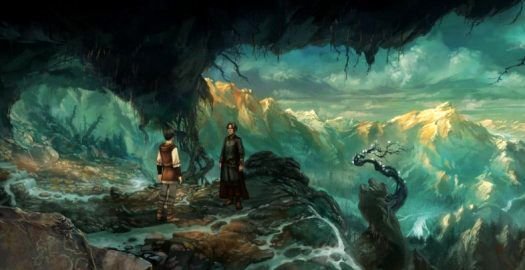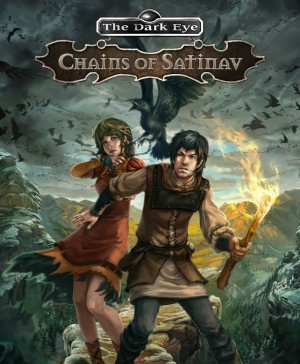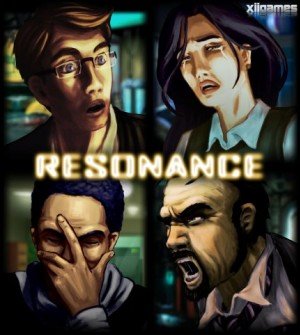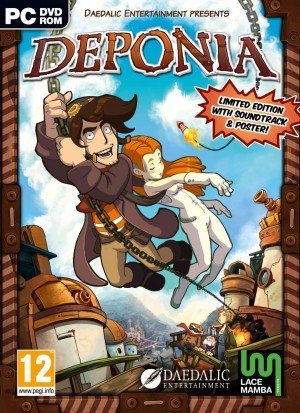Review for The Dark Eye: Chains of Satinav

Although The Dark Eye is apparently the most successful role-playing game in Germany, I confess to having never heard of it until recently. There have been several video game adaptations of the pen-and-paper series over the years, but Chains of Satinav marks the franchise's first venture into the adventure genre. Coming from Daedalic Entertainment, it's no surprise that the wonderfully atmospheric artwork is easily the best part of the game. The dull main characters and lacklustre voice acting quickly threaten to bog down the experience, but fortunately the gameplay and fantasy setting hold up over the course of a lengthy, substantial adventure, with some fun puzzles and a dark story full of intrigue and death.
Players take the role of Geron, a scruffy young bird catcher from the kingdom of Andergast. Since childhood, the townsfolk have regarded him as a source of bad luck, as he was foretold to bring doom by an evil prophet called The Seer just prior to his execution. Years after the prophecy, Geron sees a chance to prove himself by getting rid of a flock of hostile crows that have taken camp in one of the king's castle chambers, little realising that the birds represent more than meets the eye. Soon some of the heroes responsible for originally capturing The Seer are killed, spreading fear that the mystic man has somehow returned. Geron stumbles into the centre of all the ensuing trouble, where he's tasked with finding the only fairy who can play a Magic Harp powerful enough to cause Andergast to perish. But if rumours are true, the revived Seer is seeking the fairy as well, intending to force her to play the harp against her will.
I found myself bored for the first half hour or so in a slow start that sees you uncovering oak leaves for a competition that yields an audience with the king, but the game picks up the pace when an unexpected tragedy strikes and creepy figures begin their hunt for the fairy named Nuri. When Geron meets Nuri outside of Andergast, he wrestles with his conscience about how best to protect the kingdom, and ultimately rejects his mentor's instructions. Instead, he becomes determined to protect her from the evil chasing them and return her to the fairy land from whence she came. But with the wicked creatures closing in around them, it’s a race against time for Geron and Nuri.
The story is suitably grand, but it's let down by the characters leading the way. Geron is the definition of bland, with few characteristics that allow you to connect with him. Displaying neither the appropriate grief nor humour when circumstances dictate, the lack of genuine emotion creates a divide between player and protagonist. On the other side is Nuri, a woefully undeveloped character who frustratingly acts like a toddler throughout the whole game. It’s cute at first, like when she insists Geron create an imaginary friend from the forest, but over time her relentless childishness wears thin. I rolled my eyes when she instantly touched something dangerous after being explicitly told not to do so due to the potentially fatal consequences. An underlying love burgeons between Geron and Nuri, but the romantic element seems shoehorned in and isn't convincing. The two protagonists meet many other people and creatures along the way, but there isn’t much time spent with any of them. There’s the despondent knight who takes a keen eye to Nuri, a merciless merchant named Harm with a deadly skin rash, a talking raven who follows you around and a cheeky green imp who likes to wind you up.
Compounding the weak characterisation is voice acting that is best described as uninspired across the board. It’s not grating by any means, but it's often done in the same tone, and there is heaps of room for improvement in conveying raw emotion convincingly. Some secondary characters are hard to vocally distinguish from one another and most lines are spoken with little appreciation for what is actually being said. And there’s a lot of dialogue to be heard. The English translation from the original German is smooth, but conversations have a tendency to get bogged down with overlong exposition and fantasy jargon which can become boring after a while – when it drags, it drags. At those times I began to zone out and wish I could just get back to playing the game.
Geron’s journey sees him visit a smuggler’s ship, mingle in a bath house and venture through a fairy portal. The latter is easily the most fantastical location, being home to an amusingly misunderstood one-eyed ‘monster’ and a peacock that uses his giant plumage to tell the time, but there is a hint of the extraordinary everywhere you go in the people you meet and the stories they tell. Often your aim is to simply figure out how to move on from your current location, whether escaping danger or travelling elsewhere to meet someone. This means that a lot of the game's scenarios are spread out across only a couple of scenes each.
The tight linearity prevents the game from being very challenging, but nor is it a cakewalk. Excluding one particular puzzle relating numbers and rope positions that baffled me for a while, you should never find yourself stuck for too long, which helps keep the pace moving. Unbeknownst to others, Geron possesses a power to break vulnerable objects. As it turns out, Nuri is the yin to his yang, as she can put things back together. These powers are limited in their ability, however, so they're not overused in puzzle solving.
As usual, you must pick up everything you come across and talk to everyone you can; combining items and gathering information is key. For example, to get past a ship guard, Geron must successfully answer three quiz questions, the answers to which can be discovered by nattering to the locals. There are a few annoying moments where you’re on the right track yet cannot progress because you haven’t triggered something (through a dialogue choice, for example), but such obstacles are minimal. The majority of puzzles are inventory-based, but there are a few logic challenges like pushing a set of buttons in the correct order that are a bit more difficult. Most puzzles are sensible and fun, with some of the best and more advanced moments taking place in Nuri’s magical world, where you can mess with the weather and gravity.
Everything is operated with a point-and-click interface, with left and right clicks providing two different context-sensitive options (such as collecting an object or commenting on it), while the cursor changes to signify when you can move to a new location. You can double click to instantly transport to the next scene, but there’s no need for a map since the surrounding areas are always tightly contained. There are settings to enable a hotspot highlighter and to signify when you’ve exhausted all available options on something (by shading the descriptive text), both of which I found useful.
The game’s hand drawn artwork is far and away its strongest point. Each location has its own distinctive colour palette, instantly creating an atmospheric mood. When you approach a rundown hut in the dark, set against a cloudy sky and decomposing wood backdrop bathed in blues, it’s clear that something sinister is afoot. A harbour town and its dock are made up of browns and greys, bright light shining only from windows, highlighting the poverty that lingers on each corner. The detailed settings draw you in and make the world feel entirely believable, though ambient movement is minimal, sticking to mostly simple things like rising mist or gushing water.
In fact, the graphics are let down by a disappointing lack of animation overall. When characters are speaking they don’t move their bodies at all, and their faces cycle through the same set of expressions at a choppy rate. It comes across as lifeless and makes watching people talk pretty boring, the slow frame rate giving the otherwise stylish presentation an air of tackiness. It’s frustrating that a game that clearly prides itself on looking top notch decided to skimp on something so important. Another niggle is a black loading screen that happens every time you change location or begin a conversation, which snaps you out of the experience for a moment when it should have been done seamlessly (or at least less intrusively).
The music is understated, sometimes not playing at all, yet effective. At the beginning of the game there is a musician in the market playing jolly, fast-paced tunes with a feeling of innocence. However, as the darkness creeps in, both literally and metaphorically, the soundtrack becomes more menacing. A slow, sinister string piece is set against the beating of rain to create a shady atmosphere down at the docks, and when entering a dream world the music becomes ethereal, yet still retaining a strong tension that reminds you of lurking danger.
The game features a variety of achievements, some of which unlock naturally as you progress and some that require you to go out your way by experimenting with items or selecting certain dialogue options (you can get one for being humble when speaking to the king, for example). Unlocking these achievements enables you to view some concept art from the game menu, which is a nice addition for those wishing to slightly expand their playthrough and experience everything on offer.
Clocking in at around twelve hours, The Dark Eye: Chains of Satinav is a satisfying length in its own right. All story threads are wrapped up by the end, but the credits roll too soon, without providing suitable closure for the main characters. Nevertheless, the overall experience deserves a reserved recommendation. There’s fun and intrigue to be found in the well-balanced puzzles and grim plot, and it’s gorgeously designed every step of the way, but you’re going to have to look past some weak leading characters, voice acting and animation to enjoy it. Daedalic can do better, but for fantasy fans it's a reasonably entertaining adventure with just enough highlights to brighten its dark tale.
WHERE CAN I DOWNLOAD The Dark Eye: Chains of Satinav
The Dark Eye: Chains of Satinav is available at:
We get a small commission from any game you buy through these links (except Steam).Our Verdict:
Chains of Satinav boasts incredible artwork and atmosphere, though it’s populated by weak characters that spoil some of the appeal.




























